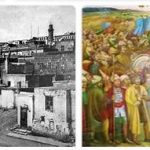Indiana is a US state. The state capital is Indianapolis, which is also the largest city. In 2006, Indiana had approx. 6.3 million residents.
Indiana is bordered on the north by Lake Michigan and the state of Michigan, on the east by Ohio, on the south by Kentucky, to which the Ohio River forms the boundary, and on the west by Illinois. Indiana is one of the states around the Great Lakes. See directoryaah for museums in Indiana.
The first residents to arrive in present-day Indiana were Paleo-Indians, who arrived in 8000 BCE.
Native Americans who lived in the area included miami tribe and shawnee.
TIMELINE:
16th Century – Indiana was first explored by the French.
1541 – Hernando de Soto explores Indiana.
1671 – Simon Daumont de Saint-Lusson declares the area French.
1682 – René Robert Cavalier de La Salle and Louis de Baude de Frontenac became the first Europeans to explore the Indiana area, which was later handed over to the French Crown as part of New France. The French were not particularly interested in populating the region, but set up trading posts that traded with local Indians, thus gaining skin.
1702-13 – Queen Anne’s War becomes the end of the Spanish presence.
1732 – France establishes the first Permanent Armed Forces in Indiana, Vincennes.
1754 – A French and Native American war breaks out in North America, ending in 1763 with French defeat.
1787 – After the American Revolutionary War, Indiana becomes part of Northwest Territory.
1800 – The Indiana Territory is formed with the capital of Vincennes.
1811 – William Henry Harrison leads American troops on November 7 in the Battle of Tippecanoe against American Indians – an event that earned him the nickname “Tippecanoe” (or “Old Tippecanoe”). He became the 9th President of the United States in 1841, but died only 32 days into old age.
1813 – The Indian capital is moved to Corydon.
1816 – Indiana is admitted as the 19th state of the United States on December 11th.
1821 – Indianapolis is founded and the city becomes the state capital in 1824 thanks to its central location within the state.
1861 – American Civil War begins. Indiana, whose population was predominantly abolitionist, actively participated on the side of the Union against the Confederate States of America. The only battle fought in Indiana during the Civil War was the Battle of Corydon in 1863.
1886 – Natural gas is discovered in Indiana, attracting a number of industrial enterprises, the industrial sector grew rapidly in the first decades of the 20th century, and industrial cities emerged, among others. Gary, founded in 1906 by the United States Steel Corporation.
1908 – The serial killer Belle Gunness, a Norwegian-American woman whose size made her physically strong, killing between 25-40 people over several decades, died on April 28 in a fire in her house in La Porte, killing 4 people.. One of the bodies was that of a woman who was headless. One never found the head. Her children lay in their beds. Ray Lamphere, who had been deeply in love with Gunness, was arrested for setting the fire. Gunness’s dentist identified some teeth and a gold crown found in some ruins, and he confirmed that it was his work on her teeth. Thus, it was concluded that the dead woman was Belle Gunness. Her farm was subsequently investigated, and one corpse after another was dug up in her pig farm, revealing her as a serial killer.
1909 – Indianapolis Motor Speedway becomes the first motorsport facility to be named ” Speedway ” after the city. It was built, with room for 257,000 spectators, making it the world’s largest stadium. The first Indiana 500 race was run on May 30, 1911.
1925 – Several tornadoes hit Indiana, Illinois and Missouri, and possibly several states, killing many people, on March 18. Over a period of 7 hours, the over 12 counted tornadoes of the F5 class killed 747 people (695 from one tornado), making it the deadliest tornado in American history.
1930 – A group from the Ku Klux Klan breaks into the prison in Marion, and hangs three young African Americans who had been involved in the murder of Claude Deeter, a white factory worker whose girlfriend was raped (not proven). It created a lynching mood that led to the burglary in the prison, where they beat the three prisoners, but an unknown voice in the mess shouted that the last boy had nothing to do with it, which made him spared. Who became his savior was never clarified. The case became known as the last confirmed lynching of blacks in the northern United States.
1937 – The Ohio River floods Ohio, Indiana, Illinois and Kentucky, causing extensive damage from Pittsburgh to Cairo, Ill. One million people became homeless, 386 died and $ 500 million in injuries.
1974 – A series of tornadoes (148) hit the Midwest and southern states (including Indiana ); many were killed with serious property damage.
1980 – An Indianapolis businessman, Herbert Baumeister, kills 16 people, most of them homosexuals. Baumeister later committed suicide in 1996 in Pinery Provincial Park before being brought to justice, and he never admitted the murders he was suspected of. But a closer examination of his farm revealed 11 bodies from men, of which 8 could be identified. The case was filmed for TV, The Secret Life of a Serial Killer, was released in 1997, and later several different programs mention the case. Watch the documentary about him here.
1985 – Ryan White of Kokomo, was expelled from high school for his AIDS infection after a blood treatment for hemophilia. Although doctors said he posed no danger to other students, many parents and teachers in Kokomo joined forces to fight for his presence as White tried to return to school. Knowledge of AIDS was not very good at that time. Then began a long legal battle with the school system, and the media covering the case made White a national celebrity and spokesman for AIDS research and public education. He appeared regularly in the media with celebrities likeElton John, Michael Jackson and Phil Donahue. Surprisingly for doctors, White lived five years longer than anticipated, and died in April 1990, a month before graduating from high school.
1987 – A jet crashes into the Ramada Inn near Indianapolis Airport on October 20. Ten people were killed.
2001 – The president of Cicero, along with nine others, is convicted of stealing $ 10 million in tax money. The town became known for welcoming AIDS activist Ryan White, who was buried here after his death; Oklahoma City bomber Timothy McVeigh, had his death executed in Terre Haute on June 11th.
2005 – On November 6, an F3 tornado hits Evansville, as the first of many, this month. The tornado killed 25 and injured more than 200 people.
2011 – Seven people were killed, more than 50 injured, when the stage at the Indiana State Fair collapsed during a cloudburst on August 13th. The band that was to perform, Sugarland, canceled the following concert, but then held a free concert in honor of those killed and wounded on October 28th. As many as 44 subpoenas were given to the band, which was hit by the tragedy.
2012 – A series of powerful tornadoes and storms leave 39 dead on2. March. The city of Marysville is almost completely destroyed. See pictures here. And pictures of Marysville here.









